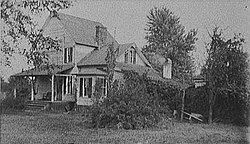Ferry Farm
|
George Washington Boyhood Home Site
|
|

One of the post-Washington farmhouses at Ferry Farm
|
|
| Location | Stafford County, Virginia, USA |
|---|---|
| Nearest city | Fredericksburg, Virginia |
| Coordinates | 38°17′43″N 77°26′57″W / 38.29528°N 77.44917°WCoordinates: 38°17′43″N 77°26′57″W / 38.29528°N 77.44917°W |
| Area | 68.8 acres (278,000 m2) |
| Built | 1738 |
| Architectural style | Central-passage house |
| NRHP Reference # | 72001417 |
| VLR # | 089-0016 |
| Significant dates | |
| Added to NRHP | May 5, 1972 |
| Designated NHL | February 16, 2000 |
| Designated VLR | November 16, 1971 |
Ferry Farm, also known as George Washington Boyhood Home Site or Ferry Farm Site, is the name of the farm and home at which George Washington spent much of his childhood. The site is located in Stafford County, Virginia, along the northern bank of the Rappahannock River, across from the city of Fredericksburg. In July 2008, archaeologists announced that they had found remains of the boyhood home, which had suffered a fire during 1740, including artifacts such as pieces of a cream-colored tea set probably belonging to George's mother, Mary Ball Washington.
The farm was named after the Washington family had left the property. Its namesake was a free ferry that crossed the Rappahannock River on Washington land—the family did not own or operate it. It is unclear what the farm was called during the Washington occupancy. Sometime in the late 19th century the farm became known as Pine Grove, as well as The Ferry Farm. The farm rose to national prominence during the Washington Birth Bicentennial of 1932—during the years surrounding this celebration some authors cited both the names Ferry Farm and Pine Grove.
Over thousands of years, American Indians periodically inhabited the lands that today make up Ferry Farm. Archaeological finds include a spear point made over 10,000 years ago by a big-game hunter, numerous tools associated with bands of hunter/gatherers, and pottery created by native farmers.
The first European claim on the property was a land patent granted to John Catlett in 1666. By 1710, the tract had been subdivided into several small farms, with Maurice Clark in ownership of what would become Ferry Farm. In 1727, the property was sold to William Strother, a lawyer and a Burgess for the newly formed King George County.
In 1738, George Washington’s father, Augustine, acquired the plantation from the Strother estate. Augustine Washington held political office, owned several thriving plantations, and was a managing partner of Accokeek Iron Furnace located six miles north of Ferry Farm on a tributary of the Potomac River. He moved to Ferry Farm in the fall of 1738 with his second wife, Mary Ball Washington, and their five young children.
George Washington's biographers could claim three locations significant as his homesteads through his lifetime. Pope's Creek, Virginia from 1732-1735 was his birthplace. Little Hunting Creek, later to be renamed Mount Vernon by elder brother Lawrence after his 1743 inheritance of the property was briefly the family home to Augustine and Mary Washington and their brood of five including his third son George, from 1735-1738. The Washington-era farm, then referred to by others as the Washington Farm and by the Washington's as the Home Farm, had a 1½-story central-passage house, two rooms deep, perched atop a bluff on the Rappahannock River. It was built by Augustine Washington. Based on excavations at the site in 2008, the structure was approximately 54 feet (16 m) wide by 28 feet (8.5 m) deep. It was the second of five houses at the site. George was six when the family moved to the farm in 1738. He inherited the farm and lived in the house until his early 20s. However, George Washington was not sentimental about the land. Washington saw the land as a "crowded, busy, trouble-filled place of limited options." Washington’s father Augustine had left behind a small set of surveying instruments after he died. At the age of 16 Washington used his father’s surveying tools to survey for prominent Virginia grandees and instantly became hooked. George Washington had found his first true calling. Surveying linked George to his brother Lawrence and the Fairfaxes. At age 18 Washington was granted a 453-acre tract in western Frederick County by Lord Fairfax. Washington surveyed the 453 acres of land and also purchased an adjoining tract. Washington soon had acquired close to two thousand acres in western lands. Washington had acquired more land through his own hard work than Ferry Farm would be worth in the three years Washington had to wait to legally claim Ferry Farm. He often stayed with his half-brother Lawrence at Mount Vernon. Washington’s mother lived in the house until 1772, when she moved to Fredericksburg, and the farm was sold to friend Hugh Mercer (direct ancestor of Gen. Geo. S. Patton Jr.). The Washington-era house was in ruinous condition by 1833.
...
Wikipedia



